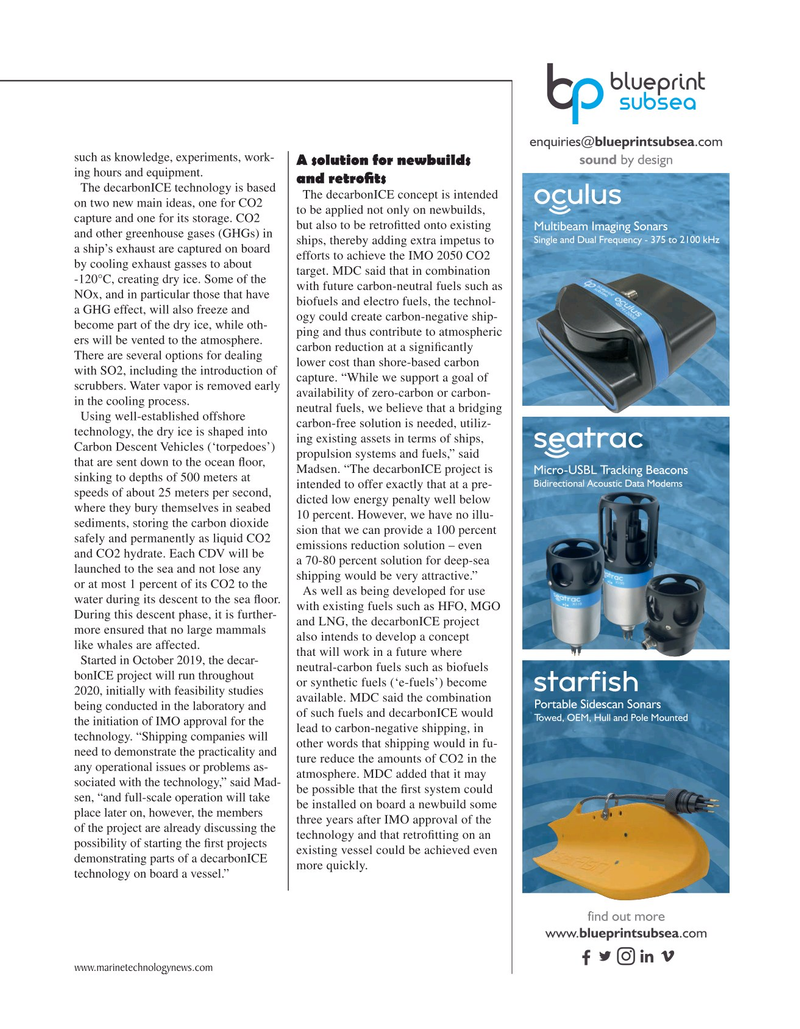
Page 19: of Marine Technology Magazine (May 2020)
Read this page in Pdf, Flash or Html5 edition of May 2020 Marine Technology Magazine
[email protected] such as knowledge, experiments, work- sound by design
A solution for newbuilds ing hours and equipment.
and retrofts
The decarbonICE technology is based
The decarbonICE concept is intended on two new main ideas, one for CO2 to be applied not only on newbuilds, capture and one for its storage. CO2 but also to be retroftted onto existing Multibeam Imaging Sonars and other greenhouse gases (GHGs) in
Single and Dual Frequency - 375 to 2100 kHz ships, thereby adding extra impetus to a ship’s exhaust are captured on board efforts to achieve the IMO 2050 CO2 by cooling exhaust gasses to about target. MDC said that in combination -120°C, creating dry ice. Some of the with future carbon-neutral fuels such as
NOx, and in particular those that have biofuels and electro fuels, the technol- a GHG effect, will also freeze and ogy could create carbon-negative ship- become part of the dry ice, while oth- ping and thus contribute to atmospheric ers will be vented to the atmosphere. carbon reduction at a signifcantly
There are several options for dealing lower cost than shore-based carbon with SO2, including the introduction of capture. “While we support a goal of scrubbers. Water vapor is removed early availability of zero-carbon or carbon- in the cooling process.
neutral fuels, we believe that a bridging
Using well-established offshore carbon-free solution is needed, utiliz- technology, the dry ice is shaped into ing existing assets in terms of ships,
Carbon Descent Vehicles (‘torpedoes’) propulsion systems and fuels,” said that are sent down to the ocean foor,
Madsen. “The decarbonICE project is Micro-USBL Tracking Beacons sinking to depths of 500 meters at
Bidirectional Acoustic Data Modems intended to offer exactly that at a pre- speeds of about 25 meters per second, dicted low energy penalty well below where they bury themselves in seabed 10 percent. However, we have no illu- sediments, storing the carbon dioxide sion that we can provide a 100 percent safely and permanently as liquid CO2 emissions reduction solution – even and CO2 hydrate. Each CDV will be a 70-80 percent solution for deep-sea launched to the sea and not lose any shipping would be very attractive.” or at most 1 percent of its CO2 to the
As well as being developed for use water during its descent to the sea foor. with existing fuels such as HFO, MGO
During this descent phase, it is further- and LNG, the decarbonICE project more ensured that no large mammals also intends to develop a concept like whales are affected.
that will work in a future where
Started in October 2019, the decar- neutral-carbon fuels such as biofuels bonICE project will run throughout or synthetic fuels (‘e-fuels’) become 2020, initially with feasibility studies available. MDC said the combination
Portable Sidescan Sonars being conducted in the laboratory and of such fuels and decarbonICE would
Towed, OEM, Hull and Pole Mounted the initiation of IMO approval for the lead to carbon-negative shipping, in technology. “Shipping companies will other words that shipping would in fu- need to demonstrate the practicality and ture reduce the amounts of CO2 in the any operational issues or problems as- atmosphere. MDC added that it may sociated with the technology,” said Mad- be possible that the frst system could sen, “and full-scale operation will take be installed on board a newbuild some place later on, however, the members three years after IMO approval of the of the project are already discussing the technology and that retroftting on an possibility of starting the frst projects existing vessel could be achieved even demonstrating parts of a decarbonICE more quickly. technology on board a vessel.” find out more www.blueprintsubsea.com www.marinetechnologynews.com
MarineTechReporter2018 ThirdPage-Vert Advert 1 (CMYK, 480dpi) 21 December 2017 13:40:36

 18
18

 20
20
